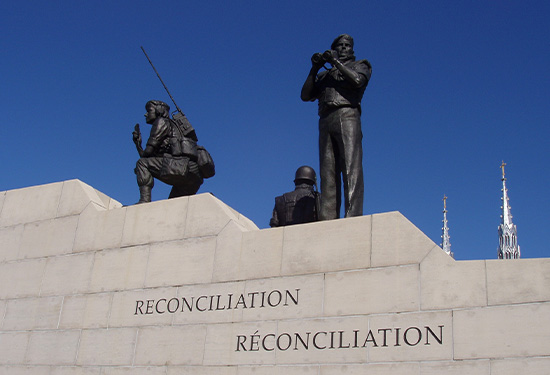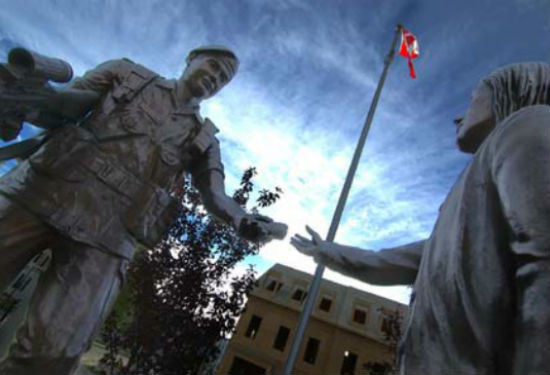Order of events
1957
Francois “Papa Doc” Duvalier takes power in a dictatorship. Later, the state-sponsored terror group the Tonton Macoute supports him.
1971
Jean-Claude “Baby Doc” Duvalier succeeds his father; the repressive regime in Haiti continues.
1974
Canadian Armed Forces deliver food and medical supplies to a remote parish in Haiti.
1986
President Jean Claude “Baby Doc” Duvalier is overthrown in an uprising. This ends the repressive dictatorship that began with his father in 1957.
1989 to 2010
Canadian Armed Forces members deliver humanitarian assistance to Haiti in various missions.
1990
Haiti has a new constitution and holds its first free elections in decades. Jean Bertrand Aristide is elected president.
1991
President Aristide is ousted in a military coup and forced into exile.
1994
United Nations forces land in Haiti. They attempt to restore former President Aristide to power.
1995
A major Canadian Armed Forces peacekeeping operation begins in Haiti. A large Canadian contingent remains there until 1997.
Late 1990s
Canadian civilian police begin serving as peacekeepers in Haiti. They try to help stabilize the country and train the local police.
2004
President Aristide is again ousted from power. Canadian troops return to Haiti as part of a UN peacekeeping force. They also serve in humanitarian aid operations after a hurricane.
2010
A massive earthquake strikes Haiti. Thousands of people die during this disaster.
Classroom materials
Canada has taken a leading role in international peacekeeping and humanitarian aid efforts in Haiti. This is in large part due to the shared linguistic and cultural ties between our two countries. Both countries have French as an official language and there is a large Haitian-Canadian community in Quebec. Some Canadians have also been active in Haiti as missionaries and foreign-aid workers over the years.
Canadians in uniform have also served in several peacekeeping and natural disaster response operations in Haiti. Notably, Canadians participated in large-scale peace efforts in Haiti in the mid-1990s and mid-2000s. In 2010, Canada offered significant aid to help in the aftermath of a devastating earthquake.
Haiti
Haiti is a mountainous country located in the Caribbean. It shares the island of Hispaniola with the Dominican Republic. The small country occupies an area about half the size of Nova Scotia and has a population of approximately 11 million people.
Centuries of uncertainty
Christopher Columbus arrived on Hispaniola in 1492 and soon after founded the first permanent European colony in the Americas. Spanish followed by French colonizers built Haiti’s economy around plantations growing crops like sugar and coffee. Hundreds of thousands of slaves were brought to Haiti from Africa between the 1500s and 1800s. The conditions were terrible and the slaves fought back in a revolution that successfully ended in 1804. Haiti became the first Black-ruled republic in the world.
Foreign interference and debt took a great toll, however. Today, Haiti is one of the poorest countries in the Western Hemisphere. It has a turbulent history of internal violence and conflict with neighbouring countries.
Dictatorship
The dictator François “Papa Doc” Duvalier controlled Haiti from 1957 until his death in 1971. He was supported by a brutal paramilitary group called the Tonton Macoute, which used violence to keep the people of the country in line. His son, Jean-Claude "Baby Doc" Duvalier took over from his father and ruled until 1986. Thousands of Haitians fled their country during this long period of corruption and state-sponsored terror. Many of them went to Quebec to build more peaceful lives.
Early humanitarian aid missions
In 1973 and 1974, Canadian troops took part in humanitarian missions to offer aid to Haitians. They provided medical and dental treatment, helped equip schools and distributed food. For example, during the 1974 mission Canadian service members delivered 90,000 pounds of canned meat.
A new era
Jean-Claude “Baby Doc” Duvalier was overthrown in 1986. Jean Bertrand Aristide was elected as president of Haiti when free elections were held four years later in November 1990. However, in September 1991, he was ousted by a military coup d’état (a takeover of the government) and forced into exile. That prompted an international outcry. Other countries called for the restoration of democracy and an end to human rights violations in Haiti.
The world responds
In June 1993, the United Nations Security Council called for Haiti’s military dictatorship to step aside and allow Aristide to return to power. The council imposed an oil and arms embargo against the country until that happened. As part of a United States-led international effort, Canadian warships patrolled the waters off Haiti. The ships helped enforce the trade restrictions.
In September 1994, United Nations forces landed in Haiti to enforce a deal to return Aristide to power. Their mission was to create a stable environment and reinstall democratic leadership. To support these goals, they would also need to reform Haiti’s military and create an independent police force. Beginning in March 1995, more than 500 Canadian Armed Forces deployed to Haiti. They performed many roles, including aviation, engineering, transportation and administrative support.
Canadian efforts continue
In March 1996, the Canadian contingent expanded to 750 and their duties shifted as the UN mandate changed. They provided infantry personnel for security patrols. A Canadian helicopter detachment, engineers and a logistical support group also served.
Canadians remained in the country as new UN missions continued. Up to 650 of our military personnel helped maintain the peace. Civilian Canadian police officers also began helping train the Haitian national police. The goal was for Haitians to be able to effectively police their country themselves.

A Canadian Armed Forces medic with children at a Haitian orphanage in April 1996. Photo: Department of National Defence IEC96-608-10
During this period, Canadians made other important contributions to the people of Haiti as well. They helped rebuild bridges, schools and water supply systems. They operated medical clinics and delivered humanitarian aid. Our peacekeepers were often greeted as protectors and friends by the local people as they travelled the chaotic streets of Haiti’s capital, Port-au-Prince.

A Canadian Armed Forces member in a helicopter flying above Port-au-Prince, Haiti in 2004. Photo: Department of National Defence HS048057d03
The Canadian Armed Forces major peacekeeping contributions in Haiti during this period ended in 1997.
More unrest in Haiti
In early 2004, President Bertrand Aristide was again ousted from power and went into exile. A new multinational peace mission began to help deal with the renewed upheaval. Canada contributed 500 peacekeepers to restore order until a new UN mission could be fully established. This contingent included an infantry company, a helicopter detachment and support personnel.
The initial Canadian peacekeeping response to this situation came to a close in August 2004. However, smaller numbers of our service members continued to take part in the UN peacekeeping efforts in Haiti as part of Operation Hamlet. Royal Canadian Mounted Police and other civilian police officers also remained in the country.

A Canadian Armed Forces medic at work in Haiti following the devastating earthquake in 2010. Photo: Department of National Defence
Natural disaster strikes
A devastating earthquake struck Haiti in January 2010, killing many thousands of people and causing widespread damage. The Haitian government asked for international aid. Canada quickly sent army, air force and navy personnel to offer medical services, humanitarian aid, and to help in the recovery efforts. More than 2,000 Canadian Armed Forces members took part in these efforts in the months that followed.
Haiti is still a troubled country. Canadian Armed Forces members and civilian police officers have continued to serve in the country at different times in more recent years.

Two members of the Royal 22e Régiment handing out supplies to children in Port-au-Prince, Haiti in 2013. Department of National Defence IS2013-2002-058
Canadian determination and bravery
Canadian Armed Forces members who have served in Haiti faced a challenging climate. Extremely hot and humid conditions are common there.
The extremely volatile political situation has also made serving in the country very challenging. Maintaining security is a constant concern. Poverty is also widespread and the Canadians who deployed to Haiti have had to deal with the fact they could not help everyone.
Master Corporal Joseph Lavallée was awarded a Meritorious Service Medal for his courage in helping secure the Haitian National Palace during a tense demonstration in 1996. His section prevented an angry group of 1,000 people from storming the building.
Canadians volunteer
Canadian Armed Forces members serving in Haiti have often donated their spare time to humanitarian efforts. For example, they have visited orphanages and unofficially adopted homeless children who were in relief shelters, bringing some help to young Haitians in great need. Medical personnel helped the sick and elderly and also delivered babies. Canadian engineers also constructed a school in the country.
Sacrifice
Two Royal Canadian Mounted Police officers serving in Haiti lost their lives during peacekeeping efforts there. Sergeant Mark Gallagher and Chief Superintendent Douglas Coates were in the country training local police when they were killed in the 2010 earthquake.
Approximately 130 Canadian Armed Forces members have died during international peacekeeping efforts over the years. Fortunately, no Canadian military personnel died in Haiti. However, more than 200 UN personnel from around the world have lost their lives during the various peace missions in Haiti.
- Date modified:




























